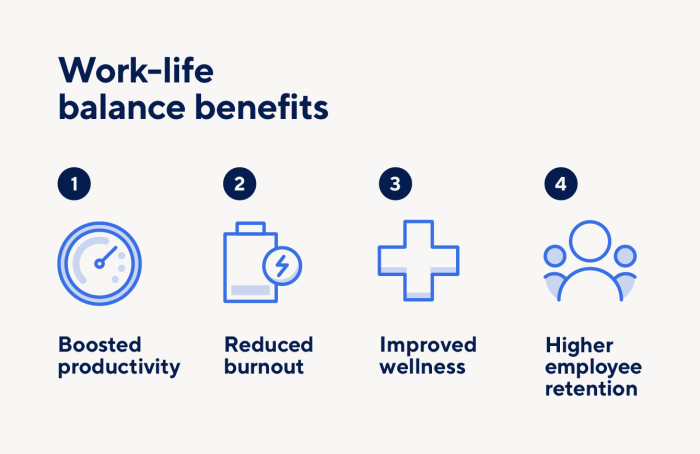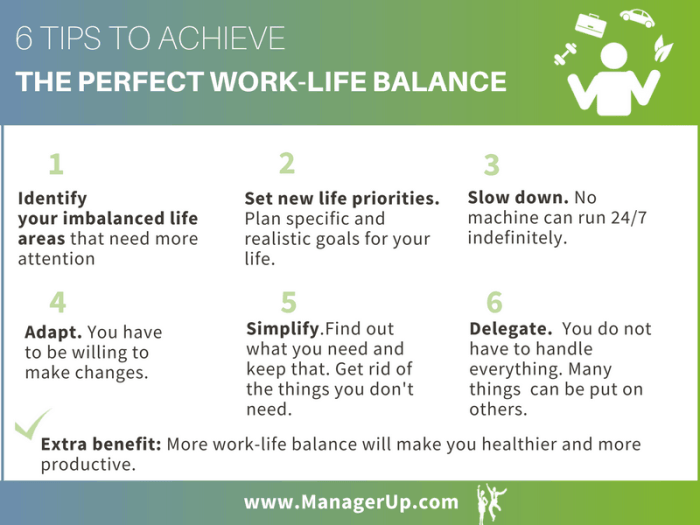Work-Life Balance Tips: Strategies for a Harmonious Life sets the stage for a journey into the world of balancing work and personal life with finesse and style. Get ready to uncover the secrets to leading a well-rounded lifestyle full of balance and productivity.
From the importance of maintaining equilibrium to self-care practices and remote work challenges, this guide will equip you with the tools needed to conquer the delicate art of work-life balance.
Importance of Work-Life Balance: Work-Life Balance Tips
Achieving a work-life balance is essential for overall well-being in today’s fast-paced world. It involves prioritizing between career and personal life to reduce stress and improve quality of life.
Negative Impact of Imbalance
An imbalance between work and personal life can lead to increased stress, burnout, and decreased productivity. This can result in mental health issues such as anxiety and depression, as well as physical health problems like high blood pressure and heart disease.
Benefits of Maintaining Balance
Studies have shown that maintaining a healthy work-life balance can lead to higher job satisfaction, improved relationships, and better overall health. Employees who have a good balance between work and personal life are more engaged, motivated, and productive at work.
Strategies for Achieving Work-Life Balance
Finding the right balance between work and personal life can be challenging, but with the right strategies, it is possible to achieve harmony and avoid burnout.
Time Management Techniques
Effective time management is crucial for balancing work and personal life. Here are some techniques to help individuals manage their time efficiently:
- Prioritize tasks based on urgency and importance.
- Use tools like calendars and to-do lists to stay organized.
- Avoid multitasking and focus on one task at a time.
- Set realistic deadlines for each task to avoid feeling overwhelmed.
Setting Boundaries
Setting boundaries between work and personal time is essential for maintaining a healthy work-life balance. Here are some tips for establishing boundaries:
- Define specific work hours and stick to them.
- Avoid checking work emails or messages outside of work hours.
- Create a designated workspace to separate work from personal life.
- Communicate your boundaries with colleagues and family members to ensure they are respected.
Prioritizing Tasks
Prioritizing tasks is key to avoiding burnout and maintaining balance. Here are some suggestions for prioritizing tasks effectively:
- Identify high-priority tasks that need immediate attention.
- Delegate tasks that can be handled by others to free up your time.
- Focus on completing one task before moving on to the next.
- Take breaks throughout the day to recharge and avoid feeling overwhelmed.
Remote Work and Work-Life Balance

Working remotely has become increasingly common, blurring the lines between work and personal life. This shift presents unique challenges in maintaining a healthy work-life balance. Finding ways to separate work from personal time is crucial to prevent burnout and ensure overall well-being.
Creating a Clear Separation
- Designate a specific workspace in your home that is solely dedicated to work. This helps create a physical boundary between work and personal life.
- Establish a routine that mimics a typical office schedule, including set work hours and breaks. Stick to this schedule to maintain consistency.
- Communicate boundaries with coworkers and supervisors to manage expectations regarding availability outside of designated work hours.
- Avoid working from areas associated with relaxation or leisure, such as the bedroom or living room, to maintain a clear distinction.
Impact of Flexible Work Arrangements
- Flexible work arrangements can offer increased autonomy and freedom in managing one’s schedule, contributing to improved work-life balance.
- Employees may experience reduced stress and enhanced job satisfaction when given the flexibility to balance work and personal commitments.
- However, the lack of clear boundaries in a flexible work environment can lead to overworking and difficulty in disconnecting from work, impacting overall well-being.
- Employers should provide guidelines and support for employees to navigate remote work successfully, promoting a healthy work-life balance.
Self-Care Practices for Work-Life Balance

Taking care of yourself is essential for maintaining a healthy work-life balance. Engaging in self-care activities can help reduce stress and improve overall well-being. Here are some tips for incorporating self-care practices into your daily routine.
Mindfulness and Relaxation Techniques, Work-Life Balance Tips
Practicing mindfulness and relaxation techniques can help you stay present and calm amidst the chaos of work and personal life. Consider incorporating activities such as meditation, deep breathing exercises, or yoga into your daily routine to help reduce stress and promote relaxation.
Physical Activity
Regular physical activity is crucial for maintaining a healthy work-life balance. Make time for exercise, whether it’s going for a walk, hitting the gym, or practicing a sport you enjoy. Physical activity not only improves your physical health but also boosts your mood and energy levels.
Healthy Eating Habits
Eating a balanced diet is another important aspect of self-care. Fueling your body with nutritious foods can help you feel more energized and focused throughout the day. Make sure to include a variety of fruits, vegetables, whole grains, and lean proteins in your meals to support your overall well-being.

